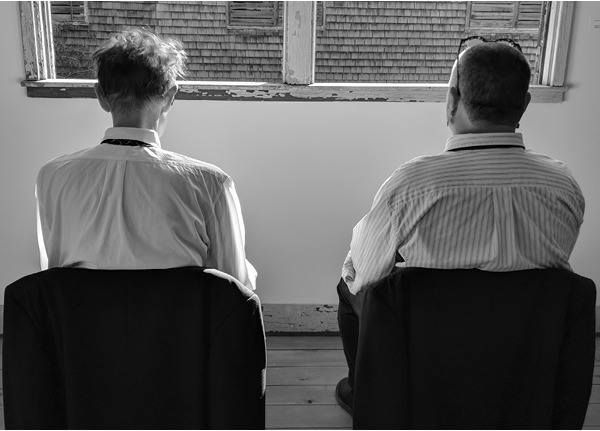
DRAGGING THE DEBATE
first performed on September 16, 2018
Maison Depoivre Art Gallery, Picton, Canada
performed once in 2018
ARTIFACTS
Leena Raudvee / Pam Patterson
Toronto, Canada / Picton, Canada
872364810l872364810r872364810a872364810u872364810d872364810v872364810e872364810e872364810@872364810g872364810m872364810a872364810i872364810l872364810.872364810c872364810o872364810m
artifactsperformanceart.ca
DRAGGING THE DEBATE
ARTIFACTS
We performed “Dragging the Debate” for the opening of Positive Masculinity, an exhibition at Maison Depoivre. In setting the stage, please imagine: we are both seated side by side on folding chairs, facing a scarred, framed, and cracked window glass, looking out on the larger site of an old WWII air force base barracks. It is a brutally hot day and we are dressed in suits, ties, and oxfords.
The performance work pulls us, as characters and as artists, out of the frames of two large composite photographic images, framed and displayed adjacent to our performance space. These works—“Debate: Hart House #1” and “Debate: Hart House #2”—were made in collaboration by ARTIFACTS and Miklos Legrady using Miklos’ photo documentation of a previous ARTIFACTS performance work entitled “Entertaining without a Maid.” This was performed, site-specifically, within one of the historical bastions of Toronto white male privilege, Hart House, at the University of Toronto. This earlier work referenced a specific historic event. Women wanted to attend the 1968 Bob Rae and Michael Ignatieff debate but were only allowed to sit in the gallery of the Debates Room. A number of them, however, disguised themselves as men and attempted to enter onto the floor of the Room. Red nail polish on one woman’s hand gave her away and the rebellious group was spirited away!
So here we are as women, suited and suitably disguised, ready to perform within an exhibition which attempts to define masculinity as positive. Does this have anything to do with defining the male gender, or rather does it rethink strategies for imagining a range of possible representations of the male gender? How, we ask, might the individual—woman, lesbian, gay, queer, trans, straight—be seduced, rather than defined, by the masculine? Using the old performance improvisational tool, mirroring, we switch leading roles as we create a dialogue in action. At times, the mirroring is exact. At other times, it’s a form of mutually negotiated exploration. For example, facing each other, we both attempt applying lipstick—not something we even attempt as women! We waffle between experiences of power, aggression, and a confused and somewhat ambivalent feminine loss. Nothing is resolved.